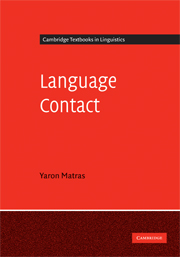Book contents
- Frontmatter
- Contents
- List of figures
- Preface
- List of abbreviations
- 1 Introduction
- 2 An emerging multilingual repertoire
- 3 Societal multilingualism
- 4 Acquiring and maintaining a bilingual repertoire
- 5 Crossing the boundaries: codeswitching in conversation
- 6 The replication of linguistic ‘matter’
- 7 Lexical borrowing
- 8 Grammatical and phonological borrowing
- 9 Converging structures: pattern replication
- 10 Contact languages
- 11 Outlook
- Notes
- References
- Author index
- Language index
- Subject index
11 - Outlook
Published online by Cambridge University Press: 05 June 2012
- Frontmatter
- Contents
- List of figures
- Preface
- List of abbreviations
- 1 Introduction
- 2 An emerging multilingual repertoire
- 3 Societal multilingualism
- 4 Acquiring and maintaining a bilingual repertoire
- 5 Crossing the boundaries: codeswitching in conversation
- 6 The replication of linguistic ‘matter’
- 7 Lexical borrowing
- 8 Grammatical and phonological borrowing
- 9 Converging structures: pattern replication
- 10 Contact languages
- 11 Outlook
- Notes
- References
- Author index
- Language index
- Subject index
Summary
How can the study of language contact contribute to our general understanding of language use, language change, and the structure and perhaps even the ancient evolution of the language faculty itself? In this final chapter, I briefly take up three issues: the availability of the linguistic repertoire, the relation between individual innovation and language change, and the layered structure of grammar.
The multilingual speaker's repertoire
The first issue concerns the speaker's command of ‘linguistic systems’. The traditional position in descriptive and formal linguistics is to view contact through the metaphor of two ‘systems’ that somehow come into direct contact with one another. We have seen evidence that, although multilingual speakers become experienced in separating communication routines and so in effect in demarcating sub-components of their overall linguistic repertoire, that repertoire remains active at all times. Repertoire components cannot, it seems, be shut down wholesale for the duration of a communicative interaction. Instead, the bilingual speaker must suppress or inhibit the activation of each and every lexeme, phonetic realisation or semantic construction that at a given moment may be functional but not appropriate to the ongoing interaction context.
We have plenty of evidence that the entire, multilingual repertoire continues its presence, so to speak in ‘alert mode’, in all interactions. Consider first the time that it takes an infant to acquire the rules on appropriate context-bound selection (and inhibition) of word-forms, and later of constructions.
- Type
- Chapter
- Information
- Language Contact , pp. 308 - 315Publisher: Cambridge University PressPrint publication year: 2009



